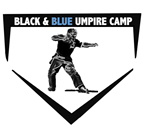| Home |
| Ball Stays in Infield |
| Fly Ball to Outfield |
| Batted Ball to Outfield |
| Everything Else |
| PreGame Guide |
| Study Guide |
| Resources and Links |
Site Maintained by: DataBase Management Services |
| Introduction | Baseball Umpiring Mechanics is preparation, reading and then reacting to a situation for each umpire causing the umpires to move to a position to cover their area of responsibility and then be set to make a call on a situation. Base coverage is based on the most likely play to happen next. Umpires should not react to unlikely second or third play developments.
The use of three umpires for baseball provides better coverage for fly balls, double plays and other situations that can make the two-umpire system difficult to cover. Players, coaches, fans and administrators feel that by putting three umpires on the field the game will be better covered. We need to prove them right and not look like a three ring circus! Utlizing three umpires on a field can be difficult if any of the umpires do not have the basic concepts of two-umpire mechanics down cold. Understanding the two-umpire mechanic concepts when the plate umpire covers third and when the plate umpire stays home will make the rotations, reverse rotations, staying put and coverages of three-umpire mechanics easier to remember. The infomation in this web site assumes the umpire knows the rules and terminology of baseball along with having a solid knowldge of baseball two-umpire mechanics.
Written by: Gary G. Frieders |
|---|---|
| Communication and Partner Awareness | Communication and partner awareness is curcial! You have to know where your partners are - and what they're doing - in order to function as a crew.
Communicate before each new situation by signalling to each partner:
Communicate during the play:
Example
Fly Ball coverage - with runners on 1st and 2nd Plate umpire covering fly ball down the left field line. Notice once the plate umpire ruled fair ball he incorrectly starts a rotation. However, he communicates to the 3rd base umpire that he has 3rd and the 3rd base umpire adjusts and the 1st base umpire rotates home. Mistakes are going to occur but with good partner awareness we can cover for each other and only the umpires will notice. |
| Starting Positions | There are three starting positions for umpires based on runner positions at time of pitch. Instead of trying to remember the seven types of base occupations and where umpires are positioned for each, you will only need to remember these three:
(1) Bases Empty or Runner at 3rd Base Only:
When base umpires are at their respective bases on their respective foul ball line they are known as a "wing" umpire. Examples:
1st Base Umpire Position Bases Empty
(2) Any Time There is a Runner at 1st Base:
Examples:
Pick off attempt at First
3rd Base Umpire: Inside the diamond in either:
(3) 1st Base Empty and a Runner at 2nd Base (Runner at 2nd Base only or Runners at 2nd and 3rd Base):
Note: With 2 outs the 1st Base Umpire should move back to the A position and the third base umpire move to the C position. On a base hit to the outfield the 1st Base Umpire will move inside the diamond take the batter-runner to 2nd base (if he goes to 2nd) pushing the 3rd base umpire to 3rd base. If the batter-runner does go to 2nd base, 3rd base umpire will stay in the area between 2nd and 3rd base. Examples:
Position of 1st Base Umpire when 1st Base Empty and 2nd Base Occupied (2nd only or 2nd and 3rd base occupied)
|
| Types of Situations | There are 4 types of situations that occur when the batter puts the ball in play:
We wlll cover each of these situations and what the umpire responsibilites are based on the umpire starting positions above. |
| Acknowledgment | Thanks to:
|
| Top of Page | |
